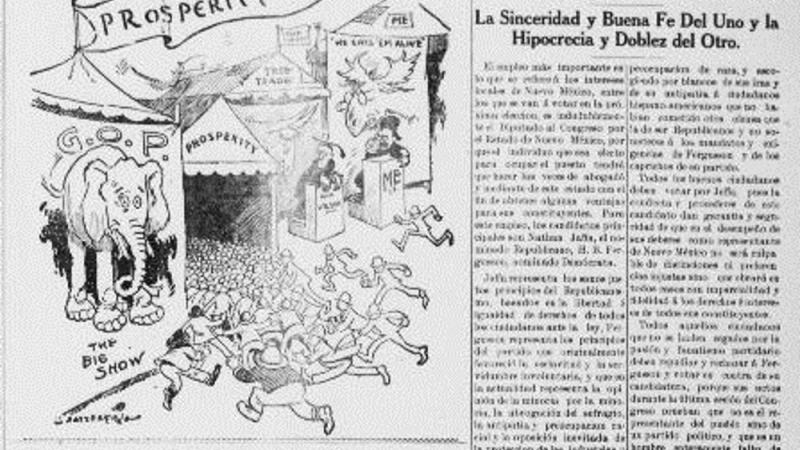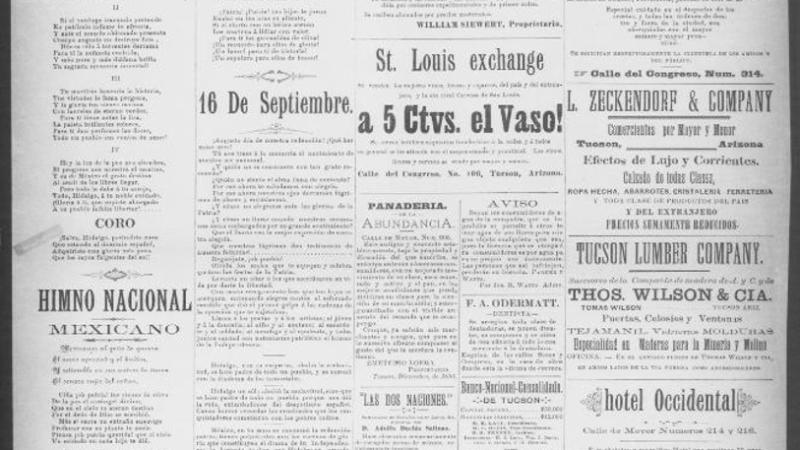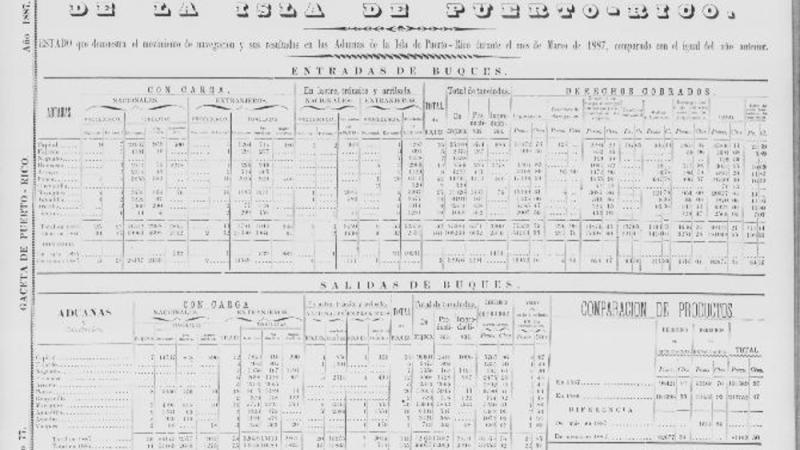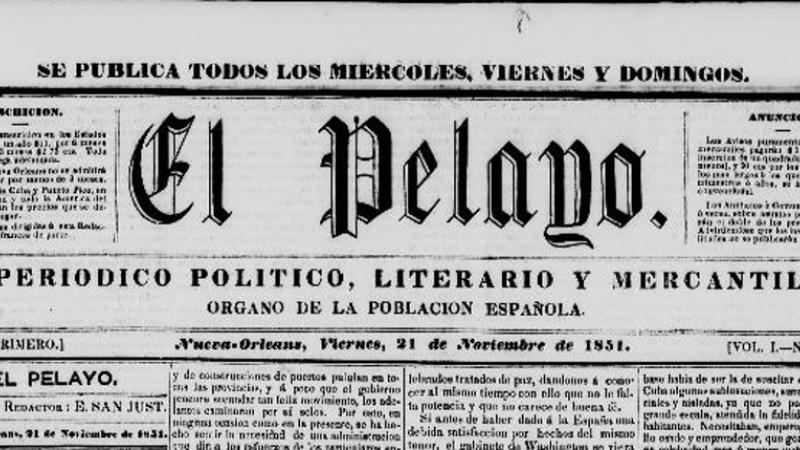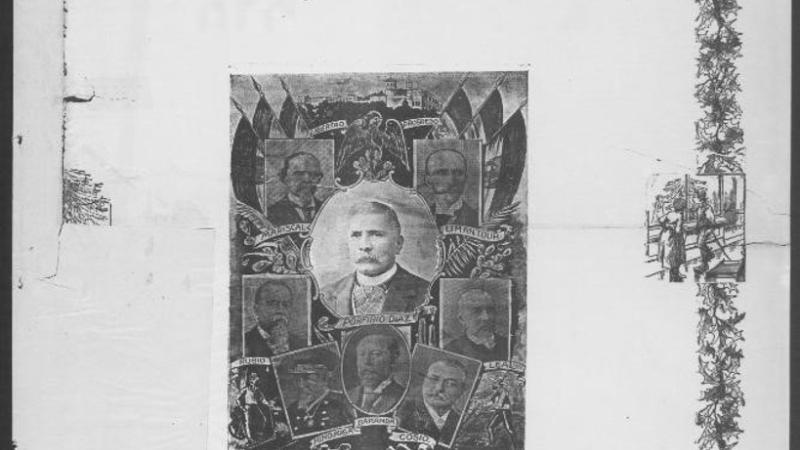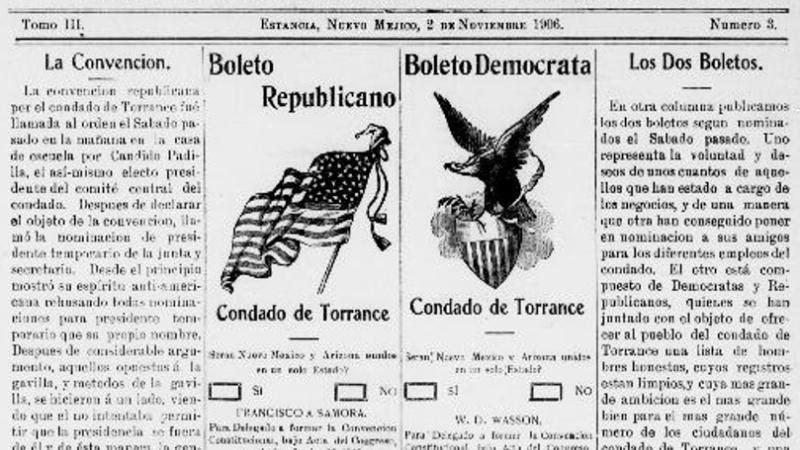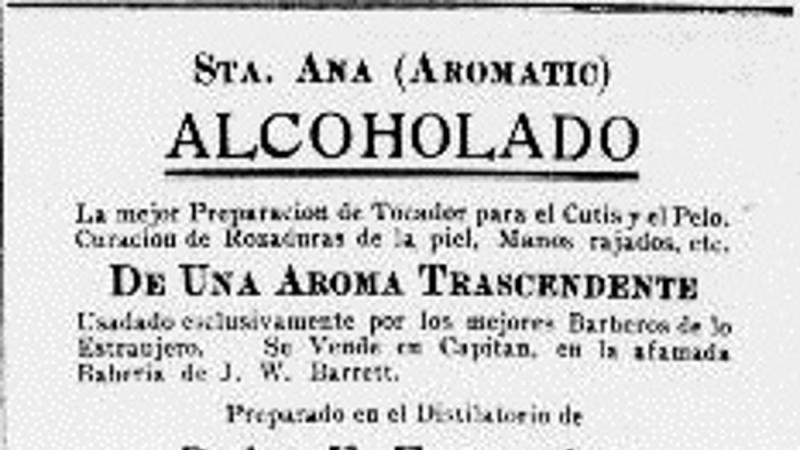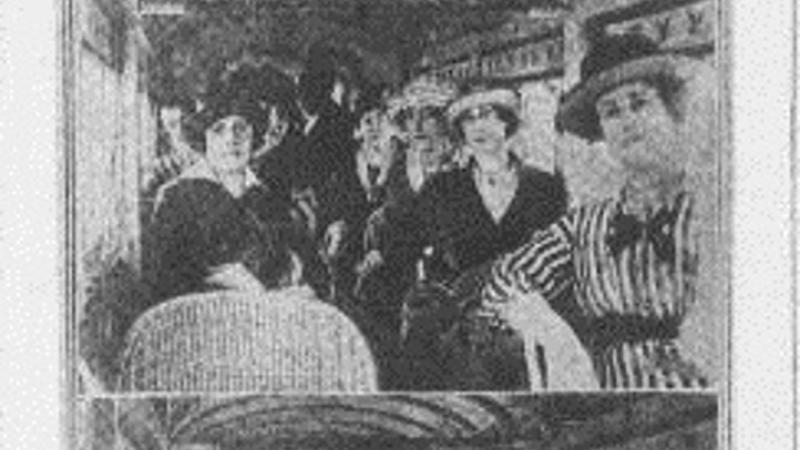New Mexico, New Spain, Old Cultures: Historic Spanish-Language Newspapers in Chronicling America
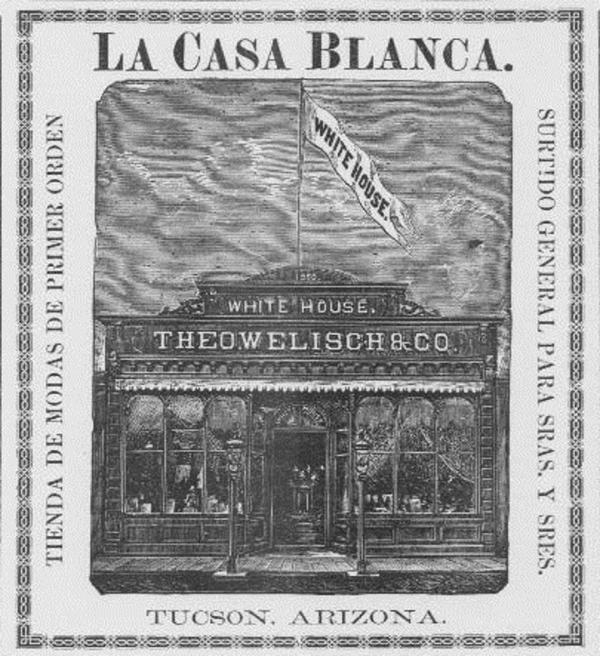
Advertisement for the White House, Mens and Ladies Fashions. El Fronterizo. (Tucson, Arizona), May 5, 1882.
Courtesy of Chronicling America: Historic American Newspapers. Library of Congress http://chroniclingamerica.loc.gov/lccn/sn95070521/1882-05-05/ed-1/seq-1/ Image provided by: Arizona State Library, Archives and Public Records, Phoenix, Arizona

Advertisement for the White House, Mens and Ladies Fashions. El Fronterizo. (Tucson, Arizona), May 5, 1882.
Courtesy of Chronicling America: Historic American Newspapers. Library of Congress http://chroniclingamerica.loc.gov/lccn/sn95070521/1882-05-05/ed-1/seq-1/ Image provided by: Arizona State Library, Archives and Public Records, Phoenix, Arizona
This article is the second in a series about the history of the ethnic and foreign language content of Chronicling America, a database of historic American newspapers from 1836 to 1922 supported by NEH and the Library of Congress. The first article in the series featured historic German newspapers and the growth of the American ethnic press. Future articles will feature newspapers in French and Italian, and those written for African American, American Indian, and Jewish communities.
In Another Country
Open one of the dozens of Spanish-language newspapers published in the United States today and you can keep up with local, national, and international news, and read about politics, entertainment, health, advice, reviews, and advertisements. Much the same can be said for the flourishing Spanish-language press of the 19th- and early 20th-century United States. NEH and the Library of Congress’s online newspaper database Chronicling America now contains 36 Spanish-language and bilingual newspapers published in the United States between 1836 and 1922, totaling 71,404 pages. You can trace the ebbs and flows of political parties in borderlands from Texas to California, peruse letters to the editor in 1904 Santa Fe, explore the annexation of Puerto Rico from the Spanish colonial perspective, check out advertisements for stores like “La Casa Blanca,” a premier Tucson fashion spot in 1882, or search for mentions of your family members who lived in the Spanish-speaking parts of the United States.
Annexation of Mexican and Spanish territories by the United States in the 19th century meant that those living in the Southwest, California, and Puerto Rico suddenly found themselves subjects of a new government—and one that was rapidly filling with English speakers. Much has been written about immigrants to the United States who came through Ellis Island and Angel Island, but there was another way people became Americans: as citizens of conquered territory. Struggles over tradition, language, representation, and assimilation in these places exemplify the push and pull of living in the borderlands. Chronicling America’s Spanish-language content illustrates a vital truth about our common heritage: the history of Spanish-speaking parts of the United States is a story of immigrants, to be sure, but it is also a story of those who didn’t become Americans by choice, but rather because they stayed put. The newspapers in Chronicling America provide a window into the distinct experiences of Hispanic citizens from those of Europeans to Ellis Island or Asian immigrants to Angel Island. Yet their experiences are similar in that they used newspapers to bolster their ethnic identity.
What is Chronicling America?
Chronicling America is a freely accessible Web site providing information about and access to historic United States newspapers published between 1836 and 1922. To date, nearly 10 million pages representing 36 states, 1 territory, and the District of Columbia are available on the site. Chronicling America is produced through the National Digital Newspaper Program, a partnership between the National Endowment for the Humanities, the Library of Congress, and state projects. NEH awards enable states to select and digitize newspapers that represent their historical, cultural, and geographic diversity, and to contribute essays containing background information about each newspaper and its historical context. The Library of Congress unifies all content provided by states and permanently maintains the digital information. Chronicling America is freely available on the internet. Users may search the millions of digitized pages contributed by state projects and the Library of Congress and consult a national newspaper directory to identify newspaper titles available in all types of formats. This effort ensures that users will continue to have access to this historical record even as technology changes.
Newspaper Publishing in the Americas
The Spanish introduced the first printing press in the Americas in 1533, and the first newspaper in the Americas, La Gaceta de Mexico appeared in Mexico City in 1772. The first Spanish-language newspapers in the United States, El Misisipí (1808) and El Mensagero Luisianés (1809), were published in early 19th-century Louisiana. After immigrants brought printing presses to California and New Mexico in 1834, both Spanish- and English-language publishing spread throughout the Southwest; Arizona, California, Colorado, and New Mexico all had flourishing newspaper industries by the 1870s.[1]
Unlike today, most 19th-century newspapers were overtly political. Spanish-language publications were no exception, weighing in on both domestic and international affairs. For example, El Pelayo, founded in New Orleans in 1851, catered to the region’s sizeable Hispanic population, a legacy of the years when Louisiana had been part of the Spanish Empire. El Pelayo focused mainly on conditions in Spain and Latin America. Its primary purpose, in fact, was to oppose revolutionary Narciso López’s plan for the liberation of Cuba from Spain. López was a proponent of slavery, and he gained support for an independent Cuba mainly among Southerners who hoped to expand the United States system even further south. After enlisting hundreds of “filibusters” and sailing for Cuba in 1851, the group failed to muster local support there, and Spanish forces captured and executed a number of Americans and López himself. Following the failed expedition, a mob attacked the Spanish consulate in New Orleans and another New Orleans newspaper with similar views. Fearing further reprisals, the editor ended publication of El Pelayo in December 1851.
Voice of a People
Further west in the mainland United States, Spanish-language newspapers sought a voice for Hispanic people living in what had been Mexico until the 1848 Treaty of Guadalupe Hidalgo ended the Mexican-American War and incorporated their territory into the United States. In addition to informing about local, state, national, and international news, publications sought to protect a language and culture either ignored or greeted with hostility by the growing “Anglo” (European-American) population. El Fronterizo (Tucson, Arizona), established in 1878, promoted pride in Hispanic culture, opposed assimilation for the Hispanic population in Arizona, and campaigned for repatriation to Mexico. Its editor, Carlos Ygnacio Velasco, later founded the Southwestern mutual aid society and political organization La Alianza Hispanico-Americana (The Hispanic American Alliance). Similarly, El Independiente (Las Vegas, New Mexico), published from 1894 to 1928, reported on education, history, language, and political issues of importance to native New Mexicans. The paper vehemently denounced the appointments of European-Americans to federal posts in the territory, stating that while they were largely of “good character” and not “bad or dangerous,” Spanish-Americans had been “almost completely ignored.”
La Voz del Pueblo (Santa Fe, New Mexico), meaning “The Voice of the People,” was published from 1890 to 1927 for news related to “the interests and progress of the Spanish-American people.” In an area that witnessed rapid growth due to its position on the Santa Fe Trail in 1835, General Stephen Watt Kearny’s proclamation taking control of New Mexico for the United States in 1846, and the arrival of the railroad in 1879, coverage included mainly local news, with some national and international coverage such as the Spanish-American War. Some English-language content was included, but the paper was mostly written in Spanish. By 1917, sections included local, national, and international news as well as editorials, literature, agriculture, and health and beauty. Similar was a short-running weekly El Farol (Capitan, New Mexico), Spanish for “The Lantern.” This newspaper, published for just under a year from 1905 to 1906, carried the motto “The Only Castilian paper South of Las Vegas and West of the Rio Grande.” Each issue included an advertisement explaining the paper’s dedication to “the interests of the Mexican people.” Indicative of the town’s position as a crossroads between Spanish and United States colonialism, the local news section exhibited New Mexican Spanish influences, while the remainder of the paper employed vocabulary and verb forms found in Spain.
Spanish-language newspapers in the Southwest sought to preserve Spanish identity, but many other newspapers were at least bilingual. Publishing in both languages made good business sense, given that the vast majority of people living there were Spanish speakers. Sometimes only political content was published in Spanish, such as the Spanish section promoting the “Regular People’s Ticket” in the 1882 Lincoln County Leader (White Oaks, New Mexico). The St. Johns Herald and Apache News (St. Johns, Arizona), established in 1885, contained a “Seccion Espanol” with local and other news, advertisements, and notices. Known as a “cattle paper” because it was situated in cattle country, it was published until 1917. Other English-language newspapers also offered sections in Spanish, such as the Chieftain (Socorro, New Mexico), Las Vegas Gazette (Las Vegas, New Mexico), Spanish American (Roy, New Mexico), Lumberjack (Alexandria, Louisiana), and Voice of the People (New Orleans, Louisiana), or notices in Spanish, including the Carlsbad Current (Carlsbad, New Mexico), Carrizozo Outlook (Carrizozo, New Mexico), Cimarron News and Cimarron Citizen (Cimarron, New Mexico), and Clayton News (Clayton, New Mexico).
European-American newspaper editors perceived the advantage of including at least some Spanish—even when they were not necessarily equipped to do so properly! Take, for example, Las Nuevas de la Estancia (Estancia, New Mexico), the Spanish version published concurrently with the Estancia News from 1904 to 1908. The paper, while published in Spanish, contains notable errors in grammar and orthography, and does not appear to be the work of a native speaker.
Global Politics through a Local Lens
Labor, immigration, and status all played a role in 19th-century reporting, and Spanish-language newspapers help illuminate major political events through the eyes of local people. The long-running El Democrata Fronterizo (Laredo, Texas) was founded in 1896 by Justo Cardenas, a journalist from Monterrey, Mexico, who came to Laredo in 1883. Cardenas became an honorary member of the Primer Congreso Mexicanista (“First Mexican Congress”) organized in September 1911 by the editors of another Spanish-language newspaper after several attacks against Mexicans in Texas. Among eleven other Spanish-language newspapers in Laredo alone, El Democrata Fronterizo defended the interests of Mexicans in Texas and commented on political events in Mexico. The newspaper shows the struggle of Mexican assimilation into the United States: although it was generally pro-worker, it condemned Mexican workers in Laredo for striking against the Mexican National Railway in 1906 as well as advocating for the deportation of Chinese railway workers. The Fronterizo was not anti-American either, supporting the American war effort during the First World War, publishing the Food Administration’s conservation practices in Spanish and advertisements for war bonds.
While many of the Spanish-language newspapers in the United States gave voice to ordinary Spanish-speaking citizens, Gazeta de Puerto Rico (San Juan, Puerto Rico) was the official newspaper of the Spanish government in Puerto Rico. Going back to 1806, the newspaper shows the colonial government in Puerto Rico, including reports from the governor, treasure, customs, commerce, internal revenues, postal services, royal decrees, and political appointments. There are also census reports, such as the race censuses in 1876 and 1881, and information about daily and cultural life such as speeches, arrival of vessels in San Juan, arrests for illicit gambling, the lottery, the escape and capture of fugitives, and major disasters such as an 1847 drought and the 1855-56 cholera outbreaks. The paper’s advertisements are also interesting, including those for slaves, land, property, utensils, books, and vacancies for teachers and physicians. Since the paper was the official organ of the Spanish colonial government, opposition to the regime is covered only superficially. The newspaper was long-running, but on October 20, 1898, two days after the United States military began governing the island, it published a statement in Spanish from the appointed military government regarding the military and civil administration and the United States Constitution. The Gazeta de Puerto Rico ceased publication in 1902, and the reasons for its demise are unknown.
A Cultural Crossroads
The Spanish-language newspapers in Chronicling America, along with those published in English, allow us to look beyond one representation of the communities and cultures pulled into the United States by wars and treaties of the 19th century. Spanish-language newspapers reveal how these communities reported on their own culture, politics, and struggles to form an identity in a brand new context. As the editor of the bilingual Santa Fe Gazette (Santa Fe, New Mexico) asked back in 1853, were New Mexicans so interested in preserving their own culture that they were not “filled with an intense desire to know something of the strange government, country, and people, with which they have become irrevocably united”? The historic newspapers in Chronicling America show how varied life was for residents of the United States, including its large Hispanic population in the Southwest and the Caribbean who sought to preserve their national identity even in the midst of great change.
[1] See Nicolás Kanellos, “A Brief History of Hispanic Periodicals in the United States.” http://docs.newsbank.com/bibs/KanellosNicolas/Hispanic_history.pdf
